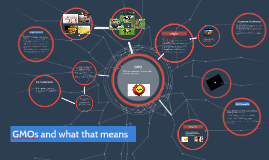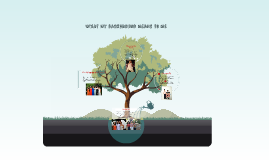GMOs and what that means
Transcript: GM crops could compete or breed with wild species threatening biodiversity Improved productively could result in more food from less land Comparison Origins International Relations/consequences: food with extra nutrition for malnourished, doing less for more food the pros and cons are about even, yes it could cause bad things but with the right precautions its worth the risk GMOs persist in waterway: studies have shown streams throughout the Midwest receive transgenic materials from corn crop byproducts even six months after harvest GE in wild: plants sampled have shown transgenes from GMOs when they were not tested on. In other words, cross-pollination had occured Organ failure: A study analyzing the effects of GE foods on mammalian health linked three GE corn varieties to organ failure in rats. Environment:antibiotics, biodiversity(food chain and ¨unfair advantage¨ Health: hormones transferring into your body, unnatural allergies and intolerances This video is very negative about GMOs, but does explain them fairly well. Future benefits from GMO's Concerns Concerns Continued Serious human health risks: The American Academy of Environmental Medicine, in a 2009 Genetically Modified Foods Position Paper , called for a moratorium on GE foods and warned that “GM foods pose a serious health risk in the areas of toxicology, allergy and immune function, reproductive health, and metabolic, physiologic and genetic health.” This position paper cites animal studies that indicate such health risks associated with GM food consumption as infertility, immune dysregulation, accelerated aging, dysregulation of genes associated with cholesterol synthesis, insulin regulation, cell signaling and protein formation, and changes in the liver, kidney, spleen and gastrointestinal system 1935 – DNA Discovered Russian scientist Andrei Nikolaevitch Belozersky isolates pure DNA. 1973 – Recombinant DNA Created The idea for man-made DNA, or rDNA, comes from a grad student at Stanford University Medical School. Professor Herbert Boyer and a few of his biologist colleagues run with it. 1975 – Asilomar Conference A group of biologists get together with a few lawyers and doctors to create guidelines for the safe use of genetically engineered DNA. 1980 – First GMO Patent Issued A 1980 court case between a genetics engineer at General Electric and the U.S. Patent Office is settled by a 5-to-4 Supreme Court ruling, allowing for the first patent on a living organism. The GMO in question is a bacterium with an appetite for crude oil, ready to gobble up spills. 1982 – FDA Approves First GMO Humulin, insulin produced by genetically engineered E. coli bacteria, appears on the market. 1994 – GMO Hits Grocery Stores The U.S. Food and Drug Administration approves the Flavr Savr tomato for sale on grocery store shelves. The delayed-ripening tomato has a longer shelf life than conventional tomatoes. Genes may "escape" and find their way into other members of the species or other species GMO is an acronym for Genetically Modified Organism. GMO •Bigger yields to create more efficient use of land, less uses of herbicides and other pesticides. •Foods with better texture, flavor and nutritional value. •Foods with a longer shelf life for easier shipping. •Finally, GM foods can create an essential sustainable way to feed the world. GMOs and what that means Origins Continued Future enviormental Risks of GMO's potential longer shelf life, better nutritional value GMO benefits 1996 – GMO-Resistant Weeds Weeds resistant to glyphosate, the herbicide used with many GMO crops, are detected in Australia. Research shows that the super weeds are seven to 11 times more resistant to glyphosate than the standard susceptible population. 1997 – Mandatory Labels The European Union rules in favor of mandatory labeling on all GMO food products, including animal feed. 1999 – GMO Food Crops Dominate Over 100 million acres worldwide are planted with genetically engineered seeds. The marketplace begins embracing GMO technology at an alarming rate. 2003 – GMO-Resistant Pests In 2003, a Bt-toxin-resistant caterpillar-cum-moth, Helicoverpa zea, is found feasting on GMO Bt cotton crops in the southern United States. In less than a decade, the bugs have adapted to the genetically engineered toxin produced by the modified plants. 2011 – Bt Toxin in Humans Research in eastern Quebec finds Bt toxins in the blood of pregnant women and shows evidence that the toxin is passed to fetuses. 2012 – Farmer Wins Court Battle French farmer Paul Francois sues Monsanto for chemical poisoning he claims was caused by its pesticide Lasso, part of the Roundup Ready line of products. Francois wins and sets a new precedent for future cases. 2014 – GMO Patent Expires Monsanto’s patent on the Roundup Ready line of genetically engineered seeds will end in two years. In 2009, Monsanto introduced Roundup 2 with a new patent set to make the first-generation seed obsolete.

















